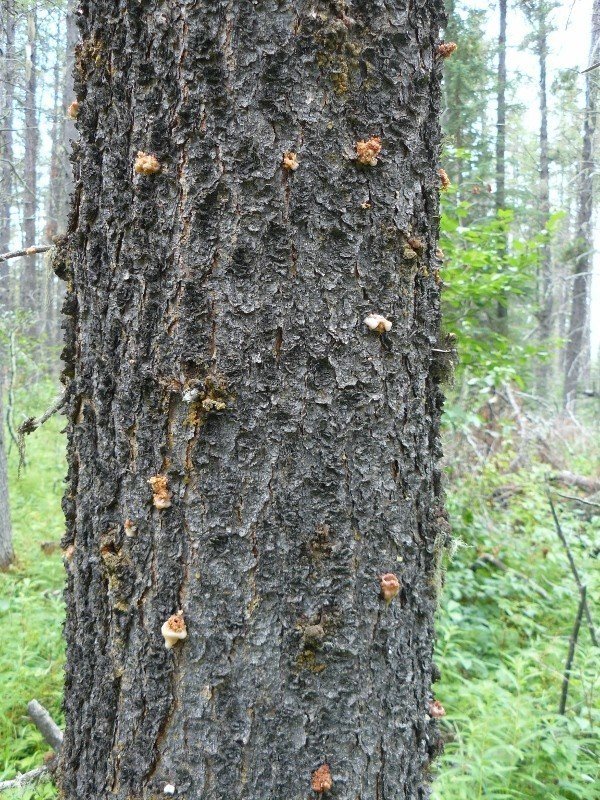by Anne McIntosh
Lodgepole pine forests in western Canada are experiencing an unprecedented mountain pine beetle (MPB) outbreak, and the ecosystem-level effects of ongoing expansion of MPB into novel habitats east of the Canadian Rockies are unknown. This led me to attempt to better understand the ecological impacts of this new disturbance in lodgepole pine ecosystems by examining the short-term effects of four treatments that emulated MPB attack and associated forest management disturbance (i.e., control, moderate intensity MPB attack, high intensity MPB attack, and salvage harvest) on above- and below-ground properties and processes of mature lodgepole pine forests in MPB’s recently expanded range east of the Rockies in the Upper Foothills. I was also interested in understanding what the future regeneration potential of these MPB-attacked stands might be and how this would compare with harvest disturbed pine stands.
I measured multiple above (abundance of understory plants by species, canopy tree size and cover, and downed wood biomass), and below-ground (forest floor thickness, litter cover, pH, decomposition rate, available soil nutrients, microbial phospholipid fatty acids and multiple carbon-source substrate-induced respiration) properties before, during, and one year after MPB and salvage logging treatments were applied. In addition I quantified seedbed availability and advance regeneration, and compared lodgepole pine recruitment of sown seed on five different seedbed types (i.e., moss, shallow organic, deep organic, decayed wood, and mineral soil) within the treatments for 3 years after MPB attack.
Overall, in the short term I found short-term resistance of ecosystem properties to moderate levels of simulated MPB attack, and only limited below-ground responses to the high intensity simulated MPB attack. However, the salvage logging treatment showed dramatic effects on the understory plant community and downed woody material with several less dramatic below-ground responses. Examining the results for future regeneration potential of these stands, recruitment from sown seed 1-3 years after simulated MPB attack was poor across stand treatment types and seedbed types. Decayed wood and mineral soil were the best seedbed types for germination, with higher recruitment rates than the organic and moss seedbeds, although recruitment was still relatively low. Recruitment rates of seedlings on these seedbed types increased with increasing levels of disturbance; recruitment was lowest in control stands, higher in the simulated MPB-attack treatments, and highest in the salvage logged stands. However, these favorable seedbeds were scarce among all stand treatment types.
 The lack of response of ecosystem properties and processes to simulated MPB attack in the short-term suggests these forests are resistant to change early after attack, and/or have high ecological inertia. In contrast, salvage logging had immediate and dramatic effects, as expected, indicating lower ecological inertia. In addition, given the extremely low levels of advance regeneration and lack of natural regeneration I observed initially after MPB attack in our study sites, I anticipate that future stand development will be hampered by a lack of lodgepole pine recruitment, at least in the short term. If the goal is a re-stocked forest, significant silvicultural intervention will be required for lodgepole pine forests attacked by MPB within novel habitat ranges in western Alberta. A take-home message from my thesis is that we don’t yet know how these pine forests will develop under this new disturbance regime of partial canopy disturbance, but it appears likely that salvage logging will push these stands in a potentially very different successional direction than the modified natural disturbance regime will.
The lack of response of ecosystem properties and processes to simulated MPB attack in the short-term suggests these forests are resistant to change early after attack, and/or have high ecological inertia. In contrast, salvage logging had immediate and dramatic effects, as expected, indicating lower ecological inertia. In addition, given the extremely low levels of advance regeneration and lack of natural regeneration I observed initially after MPB attack in our study sites, I anticipate that future stand development will be hampered by a lack of lodgepole pine recruitment, at least in the short term. If the goal is a re-stocked forest, significant silvicultural intervention will be required for lodgepole pine forests attacked by MPB within novel habitat ranges in western Alberta. A take-home message from my thesis is that we don’t yet know how these pine forests will develop under this new disturbance regime of partial canopy disturbance, but it appears likely that salvage logging will push these stands in a potentially very different successional direction than the modified natural disturbance regime will.
For many more details on my PhD research, you can check out my thesis “Ecology of understory and below-ground communities in lodgepole pine forests under changing disturbance regimes” available at: http://hdl.handle.net/10402/era.29880, and also in the following upcoming publications:
- McIntosh, A.C.S., Macdonald, S.E. Potential for lodgepole pine regeneration after mountain pine beetle attack in newly invaded Alberta stands. Forest Ecology and Management (2013), http://dx.doi.org/10.1016/j.foreco.2012.12.050
- McIntosh, A.C.S., Macdonald, S.E. In press. Short-term resistance of ecosystem properties and processes to simulated mountain pine beetle attack in a novel region. Ecosphere.

